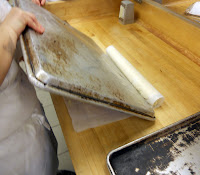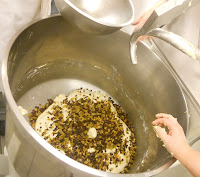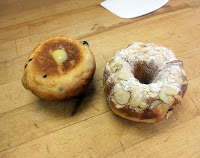Danish come in a lot of different shapes and sizes, but can be cut from the same dough. Important things to remember when choosing the shape is that the dough is delicate. You want to cut the dough with a rocking motion so you do not tear the layers that have been created during lamination.
Small Shaped Danish
These are probably the most popular forms of danish. These shapes all usually start out from a 4" square but can start with a 4" circle if you want: a pinwheel, the traditional circle, an hourglass shape, a spectacle or eye-glasses, a twist, bear claw, vol-au-vent are probably the most traditional forms. The small shaped danish can be baked at 370° in a convection oven for 10-12 minutes.
Pinwheel:
Start with a 4" square. From the corners make notches towards the center but not into the center. Egg wash the center. Start from the same side of the notch, fold the corner into the center, pressing down. Move to the next center, continue all around the square.
Bear Claw:
Start with a 4"square. Pipe a line of cream (almond cream for instance) along the top of the square. Egg wash a line along the top of the square. Roll up the square tightly, like you would for a cinnamon bun. Place the rolled up shape, seem down in the "back" of the roll. Make 4 equal cuts to give 5 claws in the shape. Fold the roll in a "U" shape cut portions facing out. Egg wash and place sliced almonds on top. Proof before preparing a second egg wash, and baking.

Danish Twist:
Start with a 4" square. Spread a thick flavour filling like jam or almond paste or cinnamon sugar thinly across half of the square. Fold the square into a book so its now 2 x 4". Cut a hole down the middle of the book. Open the book up, widen from the center, push the bottom in through the center hole creating a twist shape. Egg wash the form and allow to proof. After proofing, before baking you can fill the top of the danish if you choose before baking.

Vol-au-vent:
Start with a 4" square. Fold into a triangle, like the first step in folding an oragami crane. Cut two lines 1/2" from the square edges, leave the center intact/attached. Unfold the square and egg wash along the inside of the cuts. Fill the center (you can also opt to fill the center after you take the next step). Fold the "open" ends over the filling and press down on the opposite side.

Traditional Danish Make-up:
Start with a 16" wide rectangle, the length is not necessarily important. Egg wash half of the dough, sprinkle with cinnamon and sugar and spices. Fold the rectangle in half, 8" by x". Cut 1/2" sections along the length of the strip. When you have your 8" by 1/2" sections take each one and loosen or lengthen the strips by taking each end in your hand. Place the strip on the table and take your hands in different directions to twist up the section.
Coil up the strip in one of the following shapes:
Circle: Coil the strip in a loose circle, tucking the tip underneath. (This is a good shape to make an "eggs over easy" danish using an apricot as a garnish)
Eyeglasses: Coil both sides in, loosely, meeting in the middle.
Hourglass: Coil both sides loosely in opposite directions.
Large Shaped Danish
Large shaped danish are not as common but they can be very eye appealing as well as much more inviting for shared events or for edible decoration for an event (as in a wreath, or nest shape). With large shapes you will want to start out with a 8" wide by whatever length for your strip. Large danish shapes are baked at a lower temperature for a longer time. Bake at 350° F in a convection oven for roughly 20 minutes.

Danish Plait: open or closed
Open ended plait: Fold the 8" side over so that you have a 4" by whatever length book. Make 2" deep cuts on the open side, all the way down the length of the pamphlet. Open the "book" back up. Fill the center leaving a 1/2" barrier on either side. A cooked fruit filling is a really good choice for this shape because it gives an additional height or dimensions to the dough. Fold flaps over into the center and press down into the dough, the first one needs to be folded in at an angle. Egg wash the flap after you press it into the dough. Alternately fold flaps in all the way to the bottom. Press in the sides to straighten the finished plait, egg wash the entire plait.
Closed ended plait: Cut a large end piece and angle in the corners on both sides length wise. Fold up as you do for the open ended piece.
Danish Twist:
Do not fill this with something that moves a lot. Fruit fillings are not recommended, but cream cheese filling, almond paste, or jam are all really good options.
Cut the strip to 8" wide. Spread a thin layer of filling, leave one end though with little or no filling. Roll the shape right like a cinnamon roll. Set down the shape (on a sheet pan) with the seem in the center. Make a cut down the center starting about 2" from the top. Twist the two sides and then press in the ends. Cut the end that was intact and continue to twist. Leave as a line or make up as a circle.
Pull Apart Wreath:
Cut the strip to 8" wide. Spread the dough with jam and roll up like with the danish twist. Place the dough down with the seem down like you do for the bear claw. Cut 1 1/2" pieces just like with the bear claw. Fold the shape (on a sheet pan) into a circle. When placing the pieces down flip each section up and place the next piece on the last.



























































